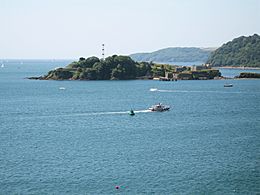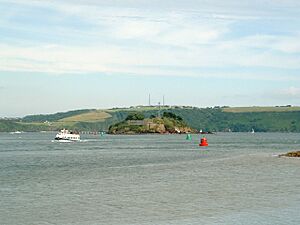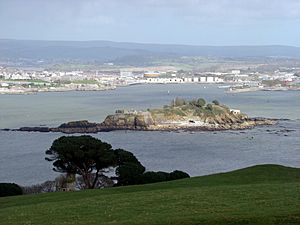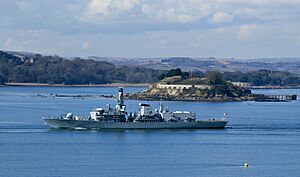Drake's Island facts for kids

Image of Drake's Island landing platform from Millbay, Plymouth
|
|
| Geography | |
|---|---|
| Coordinates | 50°21′20″N 4°9′13″W / 50.35556°N 4.15361°W |
| OS grid reference | SX4681952912 |
| Adjacent bodies of water | Plymouth Sound |
| Area | 2.6 ha (6.4 acres) |
| Length | 400 m (1,300 ft) |
| Width | 100 m (300 ft) |
| Administration | |
| Additional information | |
| Time zone | |
Drake's Island is a small island in Plymouth Sound, a body of water south of the city of Plymouth, Devon. The island is about 6.5 acres (2.6 hectares) in size. Its rocks are made of volcanic material and limestone. For over 400 years, this island was used as a fort to protect the area.
Contents
Discovering Drake's Island: Its Names and Famous Visitors
The island was first mentioned in history in 1135. Back then, it was called St Michael's Island. This name came from a chapel built there. Later, the chapel was renamed for Saint Nicholas, and the island also took that name.
In the late 1500s, people started calling it Drake's Island. This was after Sir Francis Drake, a famous English sailor. He was a privateer, which means he was allowed by the government to attack enemy ships. Plymouth was his home port. Even in the 1800s, maps still called it St Nicholas's Island. The name Drake's Island only became common in the last 100 years.
Sir Francis Drake sailed from Plymouth in 1577. He returned in 1580 after sailing all the way around the world. In 1583, he became the governor of Drake's Island. By 1549, the island was already being fortified. This meant building defenses against attacks from France and Spain. Barracks for 300 soldiers were built there in the late 1500s.
For many centuries, the island was key to defending the three towns that became modern Plymouth. In 1665, a man named Robert Lilburne died while imprisoned on the island. He was a Roundhead, a supporter of Parliament during the English Civil War. He had been jailed for life for his role in the execution of King Charles I. Later, another Roundhead general, John Lambert, was moved to Drake's Island. He also died there in 1683, still a prisoner.
In 1774, a sad event happened near the island. A carpenter named John Day died while testing a wooden diving chamber. This was the first recorded submarine death in history.
Drake's Island: A Stronghold of Defense
In 1859, a special group called the Royal Commission on the Defence of the United Kingdom suggested many new forts for Plymouth. On Drake's Island, the old fort was replaced. Five large 12-inch guns were put in open areas. A new fort was also built on the southwest side. This new fort had 21 nine-inch guns placed in a curved line of stone rooms with iron shields. This work was finished by 1880.
Later, more guns were added:
- In 1897, six 12-pounder quick-firing guns were installed.
- In 1901, three 6-inch guns became the main weapons. The older guns were buried.
- Finally, in 1942, a modern twin 6-pounder gun was put in place.
Drake's Island in Modern Times
After World War II, Drake's Island was still controlled by the War Office. In 1956, they said the island was no longer needed for defense. They finally left the island in 1963. Then, Plymouth City Council leased the island from the Crown. Their goal was to create a youth adventure training center.
The adventure center opened in 1964. That same year, the island finally got a main water supply. On May 1, 1987, the island received its first telephone line. It used a cable attached to the water pipe. The adventure center operated until March 31, 1989. After that, the Mayflower Centre Trust, which ran the center, gave up their lease.
In 1995, Drake's Island was put up for sale. The asking price was £235,000. Many people wanted to buy it. A bidding war started between Dan McCauley, a former chairman of Plymouth Argyle Football Club, and a businessman who wanted to open the island to the public. McCauley won the bid, buying the island for £384,000 in 1995. He planned to turn it into a hotel.
In 2003, Plymouth City Council rejected McCauley's plan. He wanted to build a hotel and leisure complex with a place for helicopters to land.
By 2014, the island had old military buildings from the Napoleonic era that were falling apart. It also had a radio mast from the MoD. In May 2005, the island got media attention when a group of anti-nuclear protestors, called Trident Ploughshares, occupied one of the empty buildings.
In April 2017, plans were approved for the island. They showed how the historic Island House, barracks, and other buildings could be connected. The idea was to create a hotel and spa with 25 bedrooms. In October 2018, the island was put up for sale again for £6 million. Morgan Phillips bought it for £2 million. Phillips plans to open the island to the public with a museum and heritage center. This would be 30 years after it last closed. A special tour for 105 visitors was planned for March 15, 2020, but it was canceled due to COVID-19.
Images for kids
See also
 In Spanish: Isla de Drake para niños
In Spanish: Isla de Drake para niños






